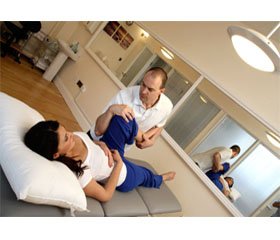The article was published on p. 65
Actuality. Drug therapy of primary gonarthrosis (PGA) is significantly limited by the frequency of side effects, so the use of physical factors for the low incidence of these adverse events have more opportunities, especially at the sanatorium stage of rehabilitation. Preformed physical factors affecting the deep structure in the joint were included in our rehabilitation program to ensure multifactor therapeutic effect on the pathological process in patients with PGA with low bone mineral density (BMD). It was considered literature data that alternating electric current of low frequency affects deep tissue and pulsed electric current is the best stimulus for bone receptors, therefore the stimulation of bone receptors in the affected bone and fibrous structures accompanied by marked neurotrophic effect.
Objective — investigate the efficacy of physical therapy influences in rehabilitation programs in patients with primary gonarthrosis with reduced BMD at the sanatorium stage of rehabilitation.
Materials and Methods. 34 patients age of 52–74 years (62,14 ± 0,88) with PGA and low BMD without comorbidities that could affect the metabolism of bone tissue included in the study using differentiated physical therapy methods. By the results of densitometric examination osteopenia revealed in 22 patients and osteoporosis — in 12. There were 6 (17,6 %) men and 28 (82,4 %) women. Duration of the disease is from 4 to 18 years on average (8,7 ± 0,7) years. The diagnosis of PGA was confirmed by X-ray, the investigation included patients with PGA stages II–III according to the classification Kellgren — Lawrence (27 persons — II stage, 7 people — III stage). All patients received basic medical complex, which included the use of sulfurated hydrogen baths with sulfide inhalation, applications of low-temperature pelotherapy on joints, massage, exercises. It was prescribed method of interference therapy (IFT) to patients of the 1st group (15 people) and for patients in group 2 (19 people) method osteoperiostal electrical stimulation (OPES) was prescribed.
Results. The application in the medical complex IFT and OPES reduce the degree of expression of clinical manifestations of pain syndrome, improve physical activity and physical working capacity in patients with PGA and low BMD. However, application of the OPES technique has more pronounced analgesic effect in patients with pain for VAS over 60 mm, contributing significantly (p < 0.05) reduction of (64,80 ± 1,39) to (36,40 ± 1,18) and significantly (p < 0.05) impact on quality of life by the index of the HAQ (16,0 ± 1,3) to (13,6 ± 0,2), while the application IFT method in patients with pain on VAS more than 60 mm analgesic effect was less expression: from (67,40 ± 0,24) to (45,20 ± 0,56), and quality of life by the HAQ index improved slightly: of (15,6 ± 0,5) to (14,8 ± 0,7). The application in the medical complex IFT has a pronounced analgesic effect in patients with pain by VAS at least 60 mm: before treatment (51,40 ± 1,52), after (36,20 ± 1,19). Changes HAQ index are also significant (p < 0.05): before (15,1 ± 0,4), after (13,1 ± 0,6).
Conclusions. Investigations have shown that exposure of pulse low-frequency and alternating current using methods IFT and OPES has analgesic effect, relieves spasms of periarticular structures and makes it possible to carry out rehabilitation more efficiently. But these methods should be applied differently, depending on the arthrological status of patients with PGA with decreased BMD.

